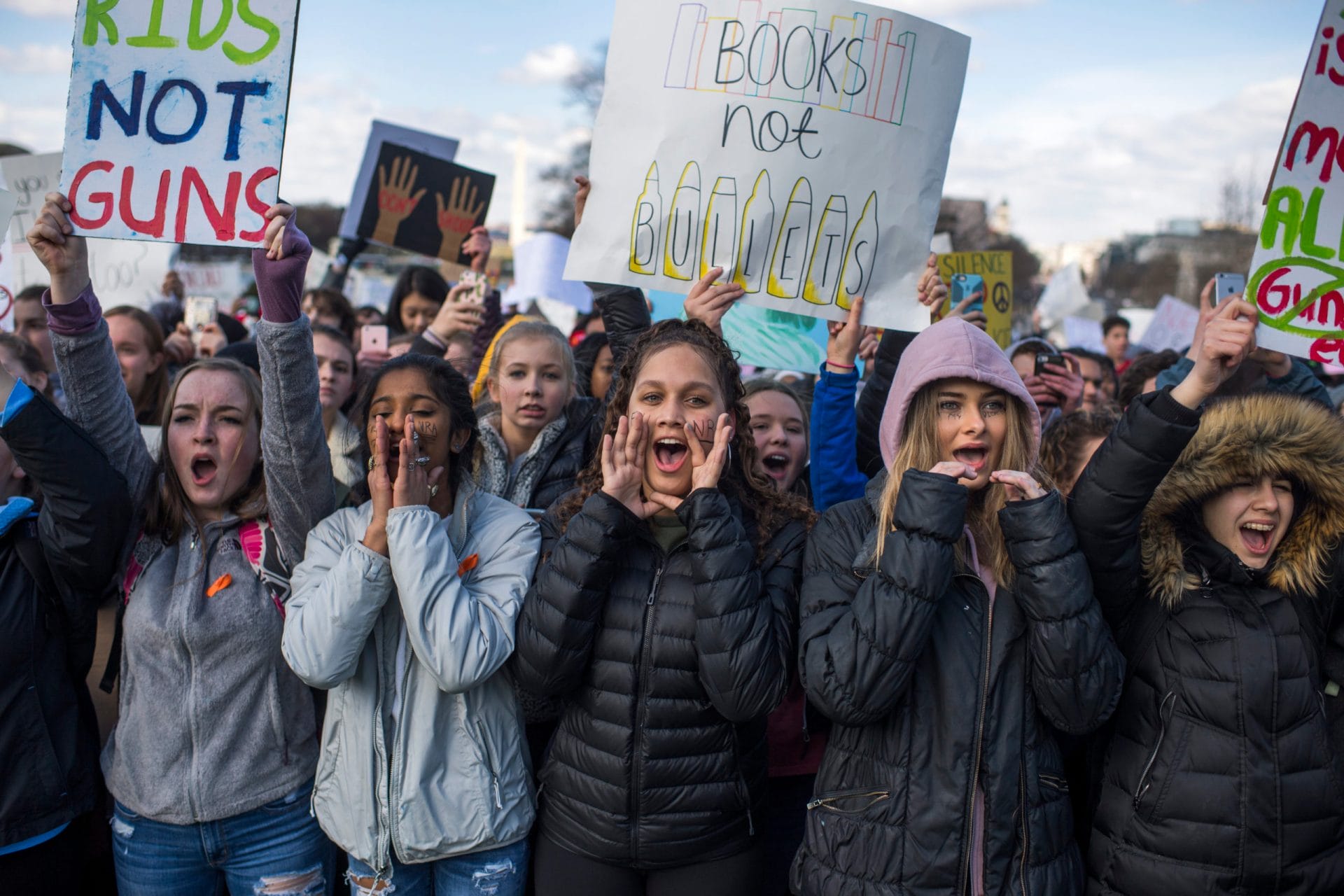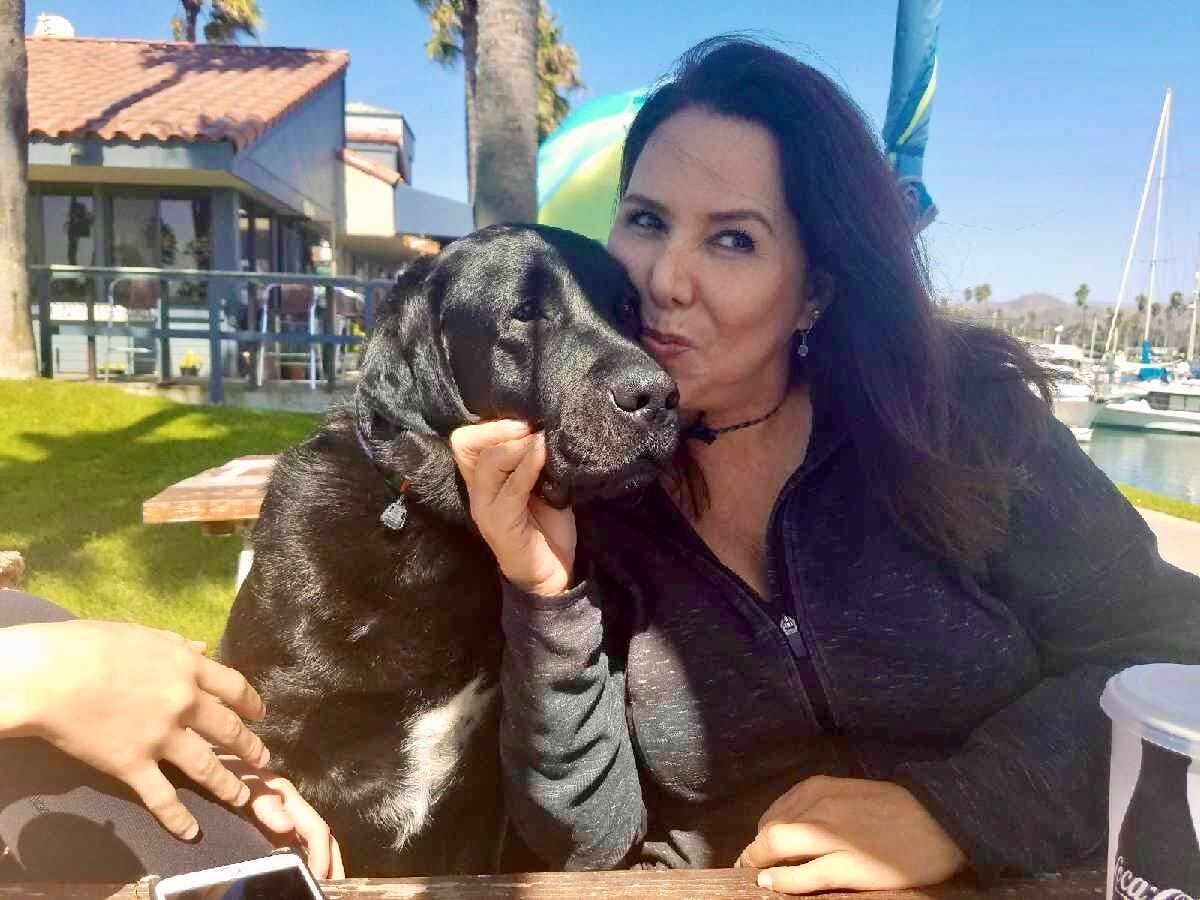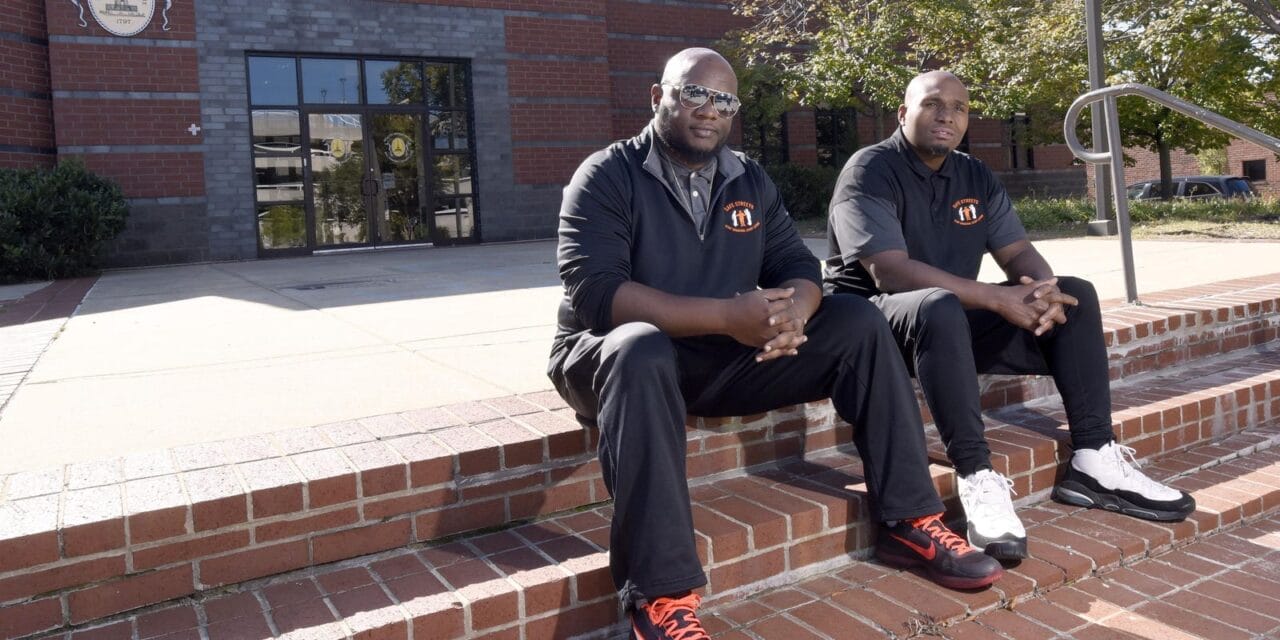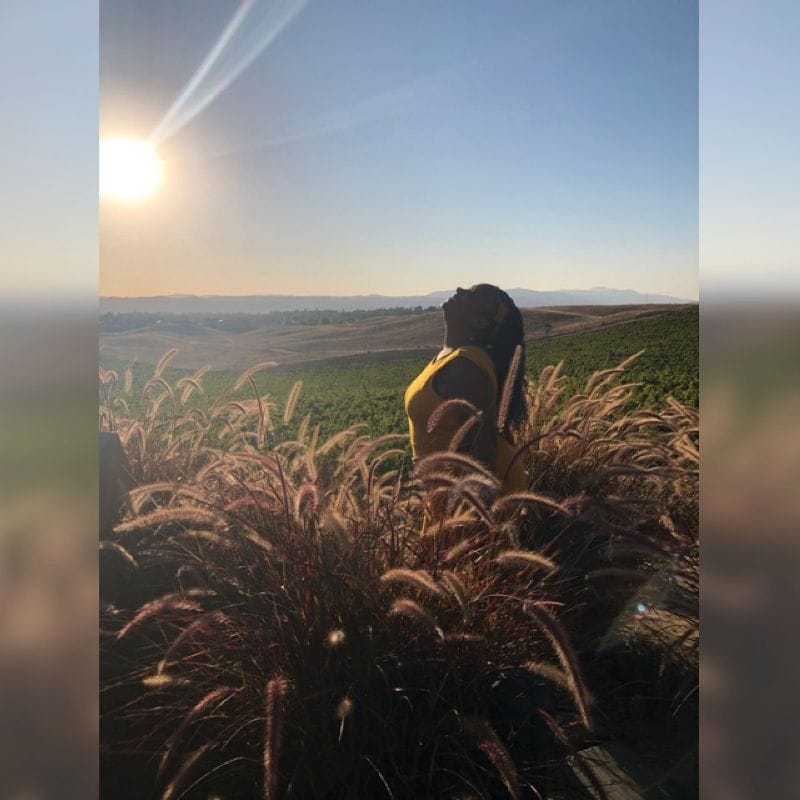
From Healing to Action: A Toolkit for Gun Violence Survivors and Allies
Introduction
A Message from Sandy and Lonnie Phillips, Founders of Survivors Empowered
We welcome your interest in this toolkit, and if you are survivors as we are, we send you a special measure of togetherness and support. While every survivor has a unique story, we understand the devastation and dislocation of having someone you love taken by gun violence.
When our daughter Jessi Ghawi Redfield was murdered on July 20, 2012, in the Aurora, Colorado massacre, we were plunged into horror, grief, and a new, permanent reality. We were beset by pressing challenges while still shell-shocked from loss and pain.
Nine years later, we’ve built an organization, Survivors Empowered, to help people affected by gun violence cope, both in its immediate aftermath and over the long haul. We have traveled this road with many friends and allies, and we are proud to call Gabby Giffords, and her organization, Giffords, treasured allies and resources.
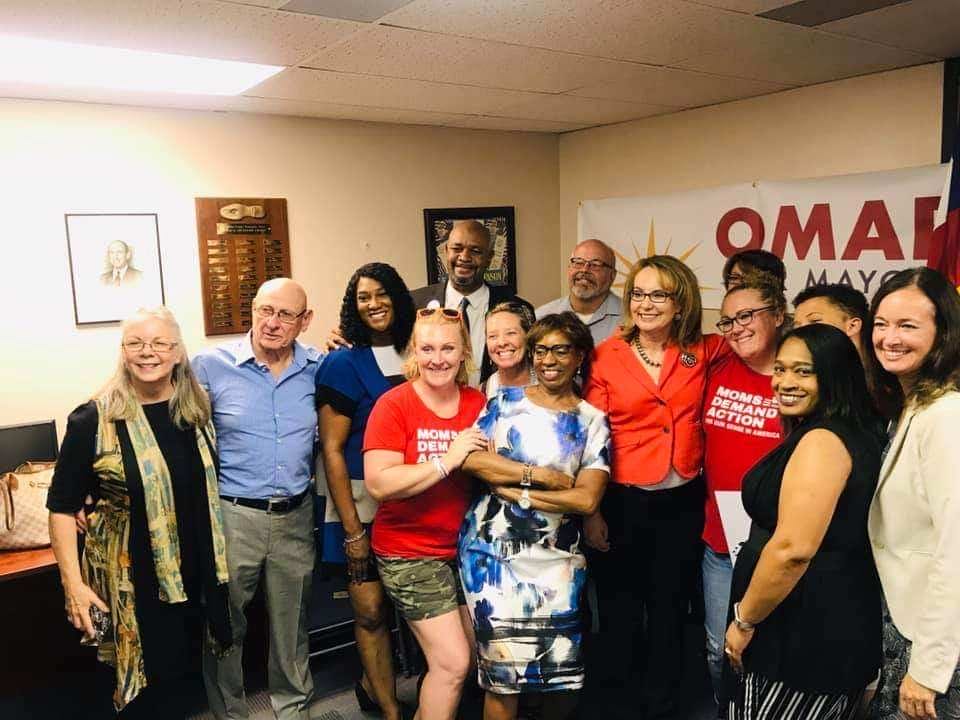
This two-part toolkit aims to give you some of what we wish we’d had the day our lives changed forever, and what we’ve learned since.
Part One is devoted to the emotional needs survivors face. We offer a roadmap of experiences and feelings you may have, and ways to address them. We understand and respect that everyone is different and grieves at a different pace. That’s one reason we provide you, in a spirit of humility and love, these tips and anecdotes.
We have found that sharing our experiences and trying to make this world a better and more peaceful place has been immensely helpful in our personal healing. Part Two offers suggestions for how to get involved in saving lives from gun violence, if you so choose.
We are happy to be a clearinghouse and connector for your efforts and alliances. We ourselves are traveling around the country with more projects for survivors, including a survivors’ oral history film project, national and regional coalitions, a mindfulness meditation program we founded, and more.
We assure you that, although the hurt will remain, action and justice can be a balm—and your individual stories, partnerships, and testimony can help achieve progress.
We wish you comfort and success,
Sandy & Lonnie Phillips
A Message from Former Congresswoman Gabby Giffords
After a gunman shot me and 18 other people at a constituent meeting in Tucson in 2011, I spent weeks in the hospital. I underwent multiple surgeries and spent hundreds of hours in various kinds of therapy. I was also scared—I’d been injured doing a job that I loved, and that trauma doesn’t fade quickly.
Survivors of gun violence come in all forms, and not everyone heals in the same way. My friends Sandy and Lonnie had their daughter’s life taken by gun violence in the Aurora shooting in 2012. As part of their healing, they founded the organization Survivors Empowered to lend a hand to other survivors of gun violence and help them turn their pain into purpose.
I founded Giffords after the Sandy Hook shooting because I was outraged and horrified at federal inaction, and wanted to help turn the tide on this epidemic. But I also founded Giffords to help other survivors, because we’re in this fight together.
My friend Pam Bosley, whose 18-year-old son’s life was taken in a senseless act of gun violence, helps other families in similar situations. Her dedication to this issue has changed the movement for the better. If you’re interested in turning your outrage into activism, like Sandy, Lonnie, Pam, and I have done, this toolkit can help guide you through that process.
It’s an honor to partner with Sandy and Lonnie to offer our insights and support to those who have been injured by or have had a loved one’s life taken by gun violence. If you fall into one of these categories, I want you to know that I share your pain.
I’ve been where you are, and I know how hard it is. But I also know that you’re surviving, every day, and that you are not alone.
Thank you for letting us be a part of your support system on your journey.
With love,
Gabby Giffords
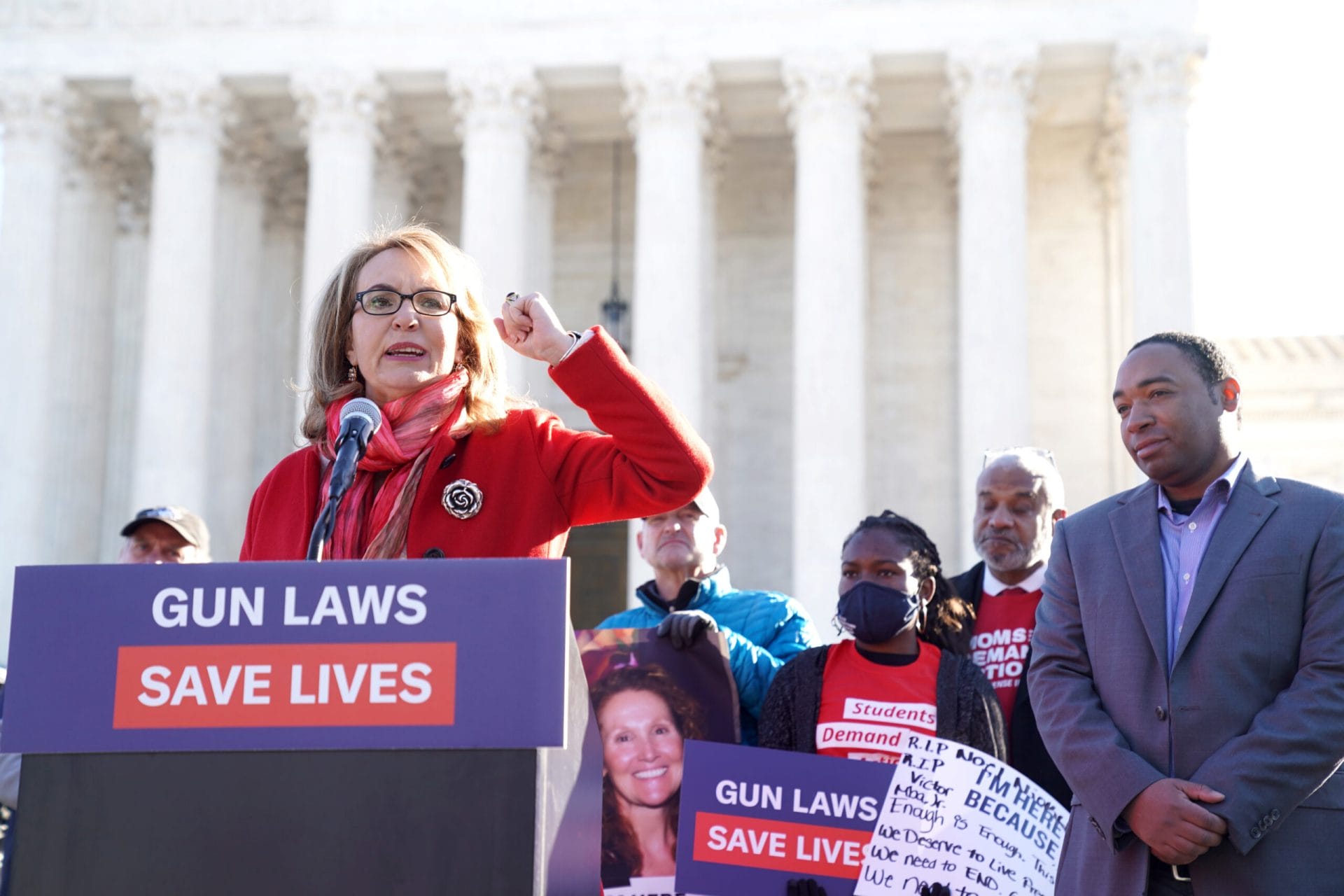
Former Congresswoman Gabrielle Giffords speaks at a rally for gun violence survivors outside of the US Supreme Court in November 2021.
Part One: Coping and Healing
Navigating the Emotional and Psychological Storm
Gun violence claims around 40,000 lives in the United States each year—an average of over 100 Americans per day. That number jumped to 45,000 in 2020. These statistics, which would be inconceivable to residents of other high-income countries, have become part of everyday life for us. As a result, nearly every American will know a victim of gun violence in his or her lifetime.
As this epidemic claims far too many lives, it also leaves behind traumatized survivors and communities. While the world may never be the same as the one you inhabited before the shooting, it can be a good world that is worth embracing. This toolkit is intended to support survivors of all forms of gun violence who might find solace or guidance in these pages.
Shootings beget two groups of living wounded: the surviving victims who have had their bodies and sense of security ripped apart by bullets, and the spouses, parents, and children who suddenly find themselves faced with the loss of loved ones. Survivors face a storm of colliding emotions while having to respond to countless demands in the days, weeks, and months following a shooting. But they also are emotionally, mentally, and spiritually disfigured, and their wounds last well after the attention recedes and their “new normal” sets in.
What Trauma Feels Like
Shock
Whether you are present during a shooting or close to someone whose life has been taken by gun violence, you may experience symptoms of shock.
Symptoms of Shock Include:
- adrenaline surges
- anxiety
- panic
- difficulty breathing and remembering
- chest tightness
- nausea
- disorientation
- dissociation
- sleep disturbance
- flashbacks
- pain and tension in the body
- new phobias and fears
- isolation
- feeling alone and misunderstood
- regression
- depression
Bargaining and anger
Anger, irritability, and short-temperedness are natural responses to a shooting. The police investigation, the media attention (or lack thereof), strangers commenting on social media, and even family and close friends may incite anger. If there’s a trial related to the shooting, you may experience an entirely new level of rage as the incident is reviewed and you come face to face with the person accused of taking your loved one’s life. Anger can consume you, and many people hold onto that anger for as long as they can.
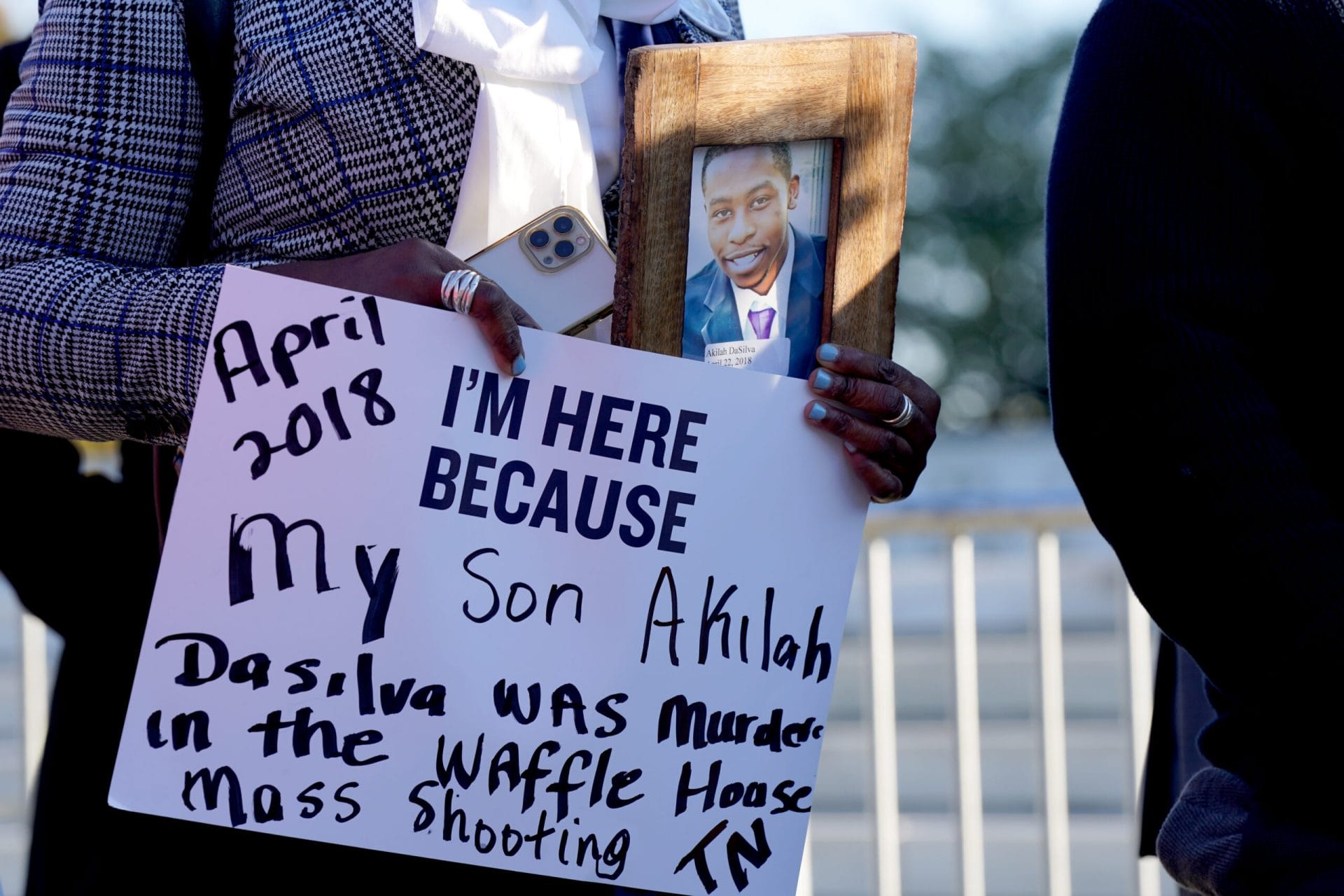
Grief and emotional pain
Losing a child “is like holding your hand over a hot flame; it’s unrelenting agony,” according to Kristin Song, whose 15-year-old son accidentally shot himself in January 2018 with an unsecured firearm belonging to a friend’s father. For survivors, the grief that comes with having the life of a loved one taken by gun violence can seem bottomless, and endures long after many of the other initial emotions fade.
Feelings of guilt
Survivor guilt, and the idea that you could have done something to prevent the tragedy or otherwise affect the outcome, is a common reaction to a traumatic event. This is an understandable attempt to restore control of your mind and body.
What Survivors Say
- “It changes everything about you; it changes your marriage, it changes your relationship with your children, it changes whether or not you want to even get up and go to work, comb your hair or take a shower.” Maisha Fields, whose brother’s life was taken by gun violence
- “At first, I couldn’t be alone in a room. I slept in the same bed as my mom for at least a week, and I would just wake up and cry and then have to start my day, which would usually include a funeral, a memorial service, and/or work.” Selene San Felice, survivor of the Capital Gazette shooting
- “You never know when they walk off from you, that you’re never going to see them alive again.” Bonnie Peters, whose granddaughter’s life was taken by gun violence
- “My gut told me that my ex was going to get a gun and kill me without him verbalizing it. I obtained a restraining order and he was served and still managed to stalk and hunt me down.” Dani Robinson, survivor of domestic violence
- “You don’t really grow away from it; you kind of grow around it. As you grow up, it moves with you.” Ashley, survivor of the Sandy Hook shooting
Managing Demands and Publicity
Media
Survivors of high-profile mass shootings may experience an overwhelming amount of attention from those expressing support as well as those in the media. Interview requests from local reporters and potentially from national news organizations means that you’ll be asked to revisit your trauma, which can be especially difficult as you may be in a particularly vulnerable state. You do not have to allow reporters into your home, and you don’t have to talk with them. However, you may find that they can be very helpful messengers if and when you are ready.
A lack of attention can be difficult to handle for different reasons. The vast majority of gun injuries and deaths don’t receive the same amount of public acknowledgement as high-profile mass shootings, and this absence can be another wound.
Attending funerals and vigils
Attending funerals and vigils can be physically and emotionally draining. In the event of a mass shooting, there may be multiple funerals to attend, which can compound the pain. Emily Giffen, a King Soopers employee who survived the shooting that killed 10 people in March 2021, spoke about the difficulty of trying to attend funerals for so many victims, saying, “It was just too hard to go to 10 in a week.”
My Son Meant the World to Me
Jun 15, 2020
“Thoughts and prayers” from strangers
If the incident is covered by media, or even if word of mouth spreads the news quickly, you may face a deluge of well-wishes and messages from people beyond your community. The internet allows for quick and easy access to your contact information and social media, which may lead to communication from strangers that feels like an intrusion.
Fundraising scams and disputes
Survivors may also encounter people expressing their support through financial donations. While legitimate charities can spring up to collect and distribute donations to victims and their families, scammers may take advantage of the situation. In addition, there’s the question of how the money that’s been raised is distributed and to whom—there are no clear guidelines, and it can quickly turn into a legal problem.
One way to minimize scams is to take the lead in starting your own fundraiser, and use media and social media to direct well-wishers to your campaign. You can also ask a family member or friend to search for illegitimate fundraisers and promptly report any to law enforcement. GoFundMe allows anyone to report a campaign that may be fraudulent, as does Facebook. In addition, you can ask local groups raising money for survivors for clarity on how the money will be distributed. If necessary, you should seek the advice of an attorney.
Hoaxes and conspiracy theories
While conspiracy theories can impact all survivors, they often spring up in the aftermath of high-profile shootings. These survivors might have to contend with harassment by people who believe these conspiracy theories, which adds another layer of trauma to the incident. For example, the families of the children killed in the Sandy Hook Elementary School shooting have been harassed in the years since, causing one father to go into hiding.
What Survivors Say
- “One of the most intrusive things that happened in that eight-day cycle when I was first shot was that they knocked on the doors of all of my neighbors. Some journalist tried to get into my hospital room in intensive care. And it didn’t take long to figure out that I had a school-age child and what school my child went to.” Jennifer Longdon, Arizona lawmaker and survivor of gun violence
- “They forget about you, and unless you’re doing something that really grabs their attention, they won’t talk about the subject anymore.” Manuel Oliver, whose son’s life was taken by gun violence in the Parkland shooting
- “Me and the other moms feel like no one is listening to us. No one is listening, like if their lives didn’t matter. They’re not just a number—they’re everything to us.” Alicia Otero, whose son’s life was taken by gun violence
- “Having reporters be there in our initial moments after the shooting was important. People could hear our story, cry with us and get mad with us. But it also made us incredibly vulnerable.” Selene San Felice, survivor of the Capital Gazette shooting
The Long Haul
When the attention and distractions of the immediate aftermath of a shooting wane, survivors are left alone with their feelings. This is when the most intense sadness may hit—and it can be particularly hard for survivors who live alone or far from family. It can also be a time when survivors, after days and weeks of near-constant communication, can begin to feel forgotten.
Birthdays, holidays, and other special occasions
For survivors, special days have new meaning. Once occasions filled with happiness, they can now become days that bring about sadness and other difficult emotions. Birthdays remind you of a life that was taken away too soon; holiday gatherings highlight the absence of a loved one.
The body may remember these dates often before the mind realizes the anniversary is approaching. If you are feeling down or off, check in with yourself to see if you have any anniversaries or birthdays coming up. You may be surprised that your body has been holding onto these memories and anticipating the date. Dr. Bessel van der Kolk’s The Body Keeps The Score provides further guidance in this regard.
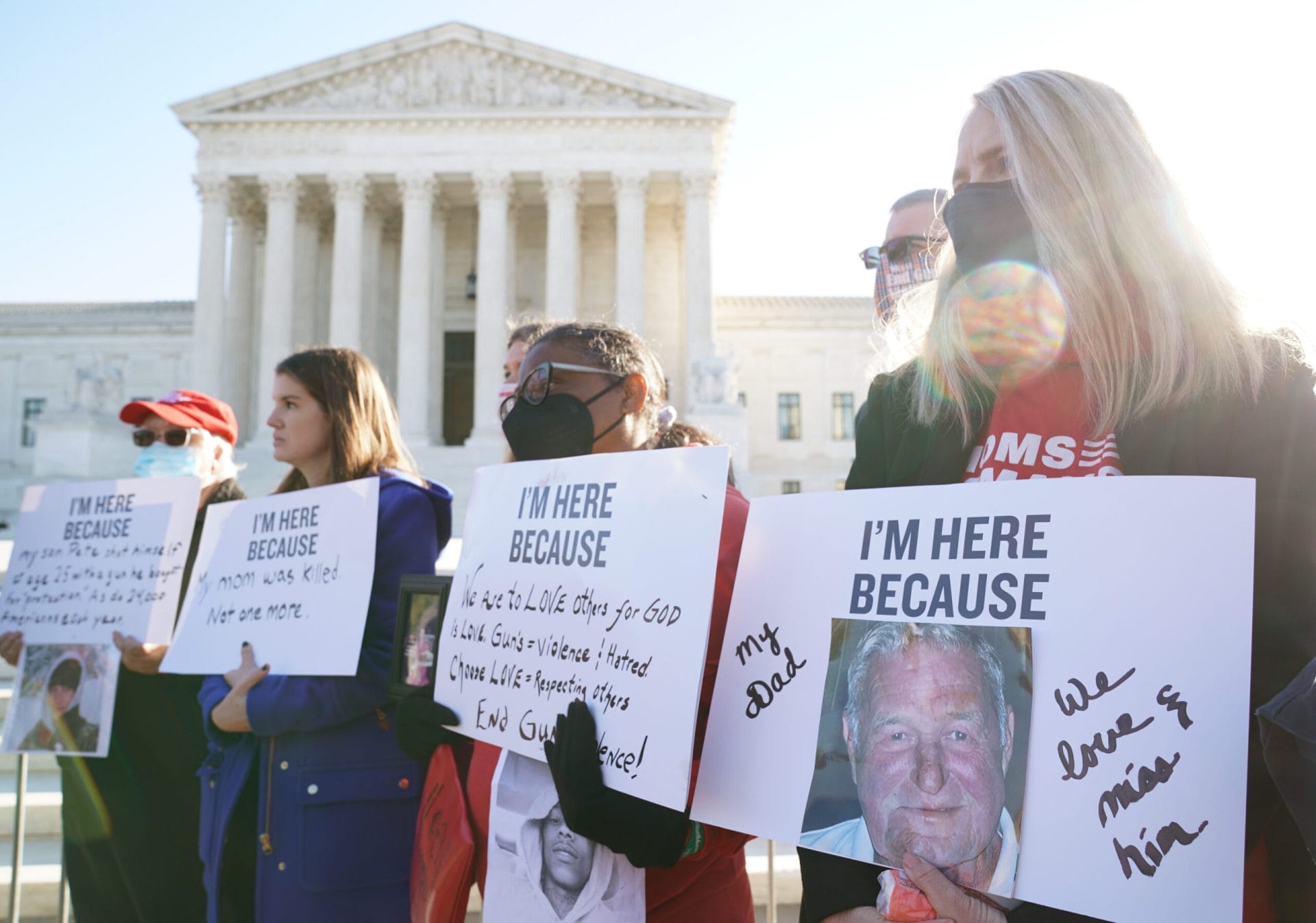
Gun violence survivors gather at a rally outside of the US Supreme Court in November 2021.
Reliving the trauma
Whether or not you were present for the shooting, your memory of the tragedy may recur, just like any traumatic event. It’s common for unbidden memories to arise with no apparent trigger, while other times external triggers, such as loud noises or violent imagery, can rouse a survivor’s trauma. If you witnessed or experienced a shooting, reliving the trauma can be especially difficult—as one of the survivors of the Pulse nightclub shooting in Orlando, Florida, described: “I recognize that I’m never not ever going to un-see those things that I saw.”
What Survivors Say
- “I’ll never forget that terrible night. The grief still feels raw. I’m seeking therapy, and some days I can talk about what happened and how I’m feeling. Other days, speaking about losing my father is unbearable.” Dion Green, whose father’s life was taken by gun violence
- “You are at a restaurant…they can drop the tray of plates and cups and stuff, the person bussing the table could drop that tray, and it could sound like a gunshot and your heart is going to stop.” Esteban Rodriguez, survivor of the Las Vegas shooting
- “I’m probably going to have arthritis in my knee for the rest of my life. Some days I’m just off and don’t want to talk. Some days I’ll have flashbacks and just keep reliving what happened.” Sadiq Nelson, survivor of gun violence
- “We have channeled our grief, anger, sadness, and so many other emotions into teaching others about the dangers of unsecured firearms in the home.” Darchel Mohler, whose daughter’s life was taken by gun violence
Getting Help and Finding Community
Whether you’re seeking financial, legal, or emotional support, you can look for specialized resources, professionals, and groups that can be of assistance.
The labyrinth of potential legal issues, for example, requires specialized knowledge, and prosecutors’ offices generally have staff focused on helping victims of violence. The organization Parents of Murdered Children offers an explanation of criminal processes.
There may also be civil suits in the aftermath of a shooting. There is a dearth of readily available legal resources at no or low cost, but volunteer lawyer associations may be able to provide some initial direction. Survivor groups can also point the way to lawyers who have been helpful in the past.
It’s important to note that due to a law Congress passed in 2005, the gun industry is immune to nearly all civil liability lawsuits. For more information, you can read Giffords’s policy page or contact a lawyer.
Nothing is as important, however, as regaining emotional balance. The assault on one’s reality following a shooting is profound, which is why trauma therapy can be especially useful for survivors.
Note: The following does not constitute medical advice. If you are in crisis, please seek immediate medical attention by calling 911 or contacting the 988 Suicide & Crisis Lifeline by calling or texting 988 or by visiting 988lifeline.org. Survivors may also call 211 for community referrals for emotional support, housing, utility assistance, food, or healthcare.
Trauma Therapy
Trauma-informed care is a strengths-based, rather than pathology-based, therapeutic approach that helps minimize perceived threats, avoid re-traumatization, and support recovery. Three “Es” are central to this approach: the Events, the Experience, and the Effect.
What distinguishes trauma therapy from other forms of mental health treatment is its focus on identifying the triggering event; its effect on mental, emotional, behavioral, and spiritual health; and its strategies to process the trauma and to enable a return to normal functioning and relationships.
It Took Me Years to Tell My Story
Jun 08, 2020
A trauma-informed therapist is aware of the complex impact of any perceived trauma in a person’s life. When choosing a therapist, the most important things to consider are how well you fit with them and their training, as well as whether you feel a sense of safety, choice, collaboration, trustworthiness, and empowerment.
If you are caring for someone who has experienced gun violence and is seeking a therapist, it’s important to recognize that in times of trauma, executive functioning is often compromised—which may lead to difficulty in organizational tasks and decision-making. Therefore, details like finding insurance and taking care of paperwork can be overwhelming. Assisting with tasks like calling insurance companies and setting up appointments can be a tremendous form of support.
The website Psychology Today offers a searchable database of therapists. If you have insurance, it is helpful to call the number on the back of your insurance card to determine whether the therapist you find is in-network with your insurance. If you don’t have insurance, you can search for a nonprofit counseling center, which may be able to offer you a sliding scale fee arrangement.
If you are seeking a therapist of color, these resources may help with your search:
- Psychology Today BIPOC therapist search
- Clinicians of Color
- Therapy for Black Girls
- National Queer and Trans Therapist of Color Network
- Free Black Therapy
Other helpful resources include:
- National Alliance on Mental Illness (NAMI)
- National Association of Crime Victim Compensation Boards
- American Counseling Association
Many therapists specialize in treating people who have experienced a life-altering trauma. Some of their strategies include the following:
Dialectical behavior therapy
This subset of cognitive behavioral therapy is a talk-based approach to healing that challenges hurtful assumptions and thoughts, and focuses on improving emotional dysregulation. Among the skills that therapists help survivors master are mindfulness meditation, emotional regulation, interpersonal effectiveness, and distress tolerance.
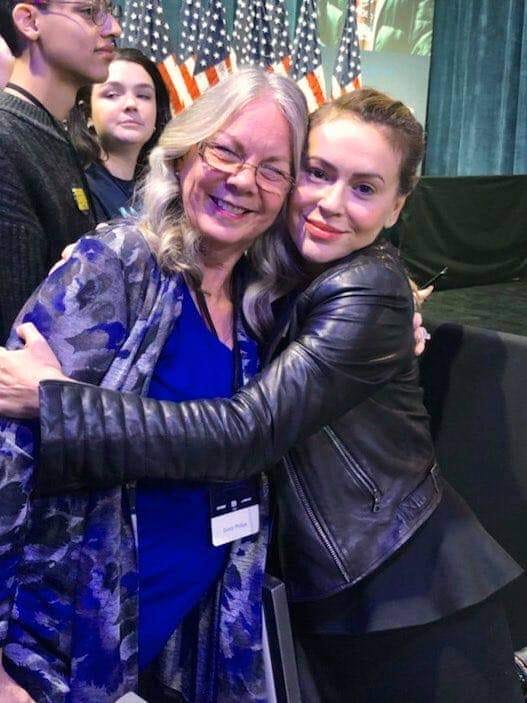
Narrative therapy
Retelling one’s story can help put intrusive thoughts and feelings to rest. People often internalize narratives about themselves that were decided for them, but these are often malleable. Narrative therapy helps survivors reframe their feelings, thoughts, and memories in a positive, strength-based way that honors their own values and beliefs and leads to growth. No matter the past, they get to say, “Now what?”
Mindfulness meditation
This tool helps people experience their feelings by paying heightened attention to them, and helps dispel the negative or intrusive thoughts that inevitably surface after a loss. It is a stress-reduction technique that has been of great use to trauma survivors.
Mindfulness meditation is also the core of a program started by Survivors Empowered in collaboration with mindfulness teacher Shelly Tygielski and the University of California, San Diego. Brenda Mitchell, a Chicago mother whose son, Kenneth, was killed by gun violence in 2005, says meditation helps her be present in the moment and “move back into a place of wholeness.”
Today, Brenda provides direct support to peers, conducts group facilitation, and advocates for policy changes. She views the mindfulness meditation program as a promising new way of helping others. “It’s great, seeing the diversity and other experiences, how we’re all coming together in a unified manner…and learning to be present with ourselves,” Brenda said. “Our pain becomes our purpose, to allow our voices to be heard. Our voices solicit change and demand attention. I am in a good space.”
Mitch Dworet, whose 17-year-old son Nick had his life taken in the Parkland school shooting in 2018, enrolled in the mindfulness meditation program along with his wife, Annika. “I want to be there for my wife and my son, and I want to help others,” said Mitch. “I’ll listen, we’ll cry together, maybe laugh together. I don’t have all the answers, but I know what has helped me.”
Eye movement desensitization and reprocessing (EMDR)
Rapid eye movement therapy is sometimes used with PTSD survivors, including veterans, to reduce the intensity of disturbing thoughts. “It has been life-changing for most of my clients,” says Angela Schellenberg, a trauma therapist and gun violence survivor.
The protocol for EMDR includes dialogue and a gradual exploration of the client’s stories and traumatic memories. EMDR delves into the negative core beliefs clients are holding in their subconscious mind due to the traumatic event. The modality is administered with the introduction of “taps” that stimulate rapid eye movement when painful memories surface.
EMDR helps clients process traumatic events that happened in the past and are showing up in the present. Processing the trauma helps the client “file” the event in the past so it does not continue to be active. With bilateral stimulation that includes physical taps, sound, or other sensory interventions, it can help the client to reduce flashbacks and other symptoms of trauma.
Art therapy
After the Parkland school shooting in 2018, local art therapists collaborated with the Coral Springs Art Museum to offer free sessions to the traumatized community. Art can provide an avenue for survivors to express their thoughts and emotions, as well as promote mental, emotional, and spiritual healing. Manuel Oliver, a muralist whose son was one of the Parkland victims, is using his art to advocate for gun violence reform. Art created by gun violence survivors were among the works included in an exhibit organized by the Massachusetts chapter of Moms Demand Action.
Equine-assisted therapy
Working with horses and an equine-assisted therapist can be beneficial for survivors. Horses can relate with people in a way that’s compatible with the emotions of survivors. They are hypervigilant and one must gain their trust, which survivors are likely to understand. Through the emotional regulation and exchange of trust that horses and survivors can share, a temporary state of relaxation often occurs, lessening the negative emotions survivors may experience.
Connecting with Other Survivors
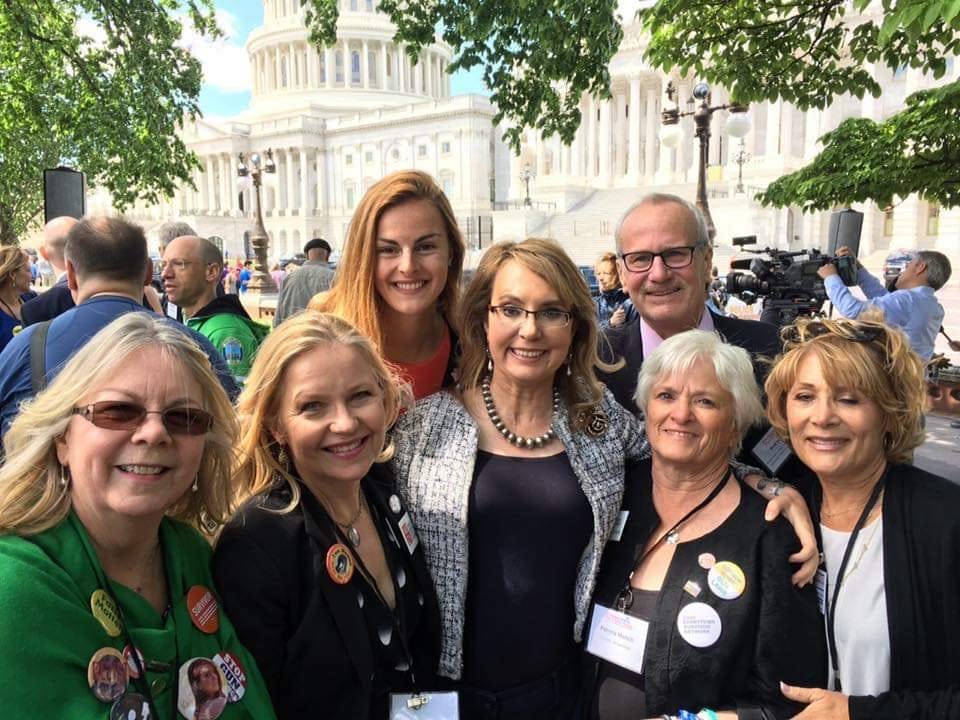
The club that no one wants to join adds new members each day. It can be helpful to connect with other survivors, who can be a source of empathy and support without any pretense, helping each other through the emotional valleys, providing advice, and offering friendship.
“It’s a club you spend your whole life hoping you won’t ever become a part of,” Nicole Hockley, whose son was killed in the Sandy Hook Elementary School massacre, told Time in 2018. “But once you’re in, you’re in.”
Survivors of gun violence can find each other through established organizations like Survivors Empowered and Giffords, as well as via Facebook and other social media sites. There are many Facebook groups that may be of use, including:
- The Rebels Project
- Parents of Murdered Children
- Children of Murdered Parents
- Siblings of Murdered Siblings
- Survivors of Domestic Violence Murder Victims
- Suicide Survivors Loss & Support
Survivors often feel safe talking with each other because they know what it’s like to live as a survivor on a daily basis.
Staying on the Path
Finding the right therapist or type of therapy can be a challenge. But once you do, the world can begin to open up again.
The hardest decision you’ll have to make when it comes to therapy is the choice to start. The second biggest decision will be your choice to continue going. The benefits are widespread and varied: therapy can help you find emotional and mental stability, the ability to be there for your friends and family, and a new purpose and meaning in life.
Seeing the shock and trauma on the faces of other survivors led to the founding of Survivors Empowered, a resource for those who have had their life changed by gun violence, like Angela. Her father’s life was taken by gun violence when she was 16 years old, and she is now a trauma therapist committed to helping others heal. “There was nothing like Survivors Empowered then. Nobody talked about gun violence, but it’s always been a part of my life since coming of age.”
Brenda has similarly turned her experience with gun violence into an opportunity to help others. “We’re retooling ourselves, because there is so much out there. We know there will be no new normal. So how do we move past the chaos, the negative, that could return us to a traumatic state?” Through practices like mindfulness meditation, Brenda created a new narrative for herself. “People have a new hope, and an ability to come out of the darkness into the light of what could be.”
What Survivors Say
- “You’ve got people that were physically injured, you got people that lost their lives. And you’ve got people that were emotionally scarred for the rest of their lives. And I want people to know that it’s OK to need to heal. Some people never heal. I’ll physically never heal, but emotionally I think that I’m on the right path.” Sean Graves, survivor of the Columbine shooting
- “I had to come to terms with the fact that I would likely never hear out of my right ear again. I also struggled, and continue to struggle, with PTSD—anytime I hear a loud noise, it takes me right back to the day I was shot.” Pauletta Perez, survivor of domestic violence
- “At the end of the day, I don’t know why this happened. I didn’t get to choose it. But I get to choose my response now. I do get to choose now.” Nelba Márquez-Greene, whose daughter’s life was taken by gun violence in the Sandy Hook shooting
- “Gun violence is a health crisis that takes nearly 100 lives every day. These lives aren’t just numbers. They’re not just statistics. They’re people, people with passions for drumming and whole futures ahead of them and two brothers who miss them every day. People with mothers like me. I will always be Terrell’s voice.” Pam Bosley, whose son’s life was taken by gun violence
Additional Resources
What To Expect as a Survivor
- What Happens to Survivors
- Managing Your Distress in the Aftermath of a Shooting
- What to Expect in the Wake of Mass Violence
- How to Cope with Survivor Guilt
- Privacy & Dignity: A Guide to Interacting with the Media
- Getting it Right: A Survivor’s Perspective
Finding Support and Community
- Treatments for PTSD
- Find a Therapist
- The Dougy Center
- National Alliance on Mental Illness (NAMI)
- The Rebels Project
- Survivors Empowered
- Parents of Murdered Children
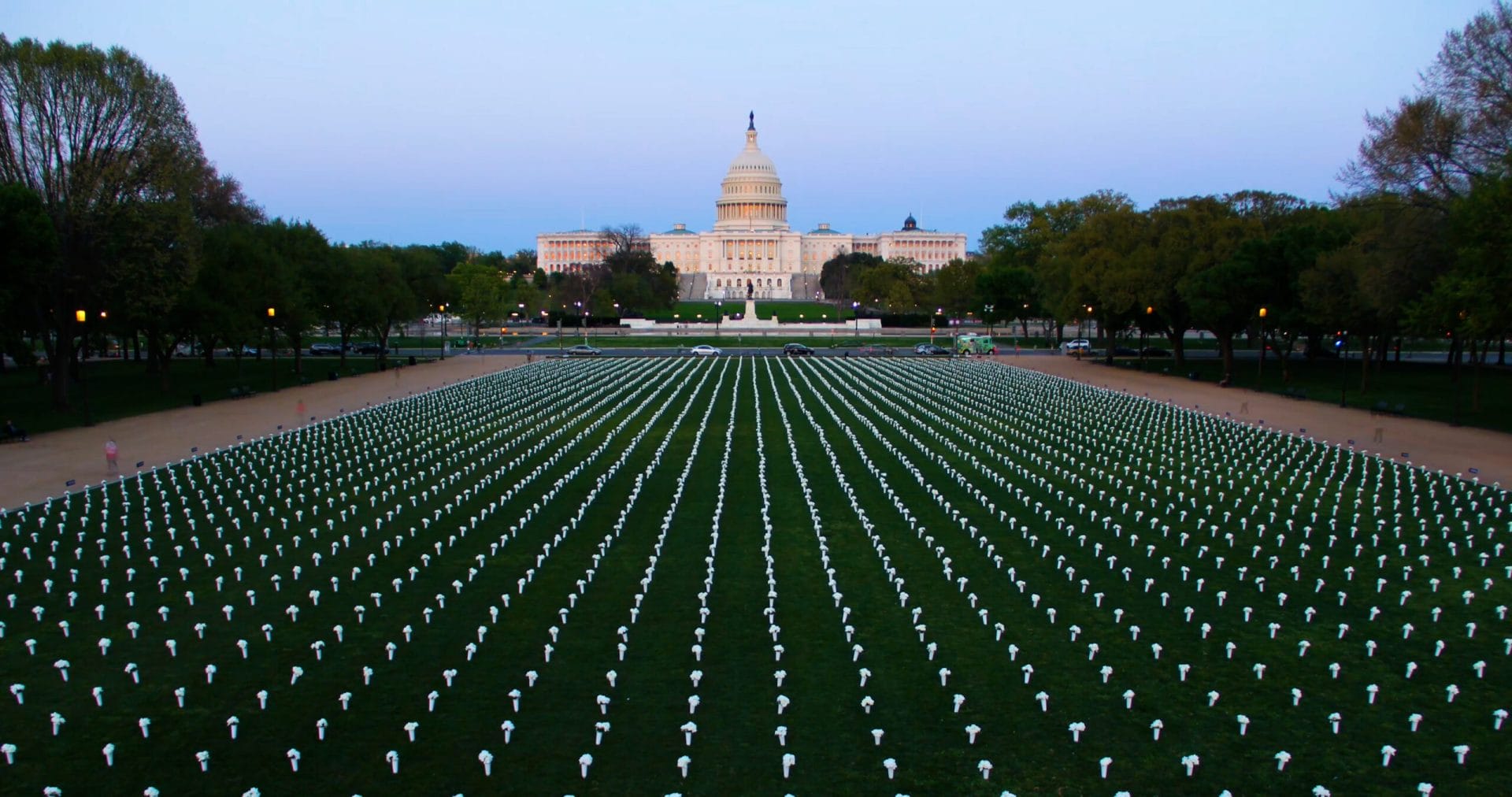
Giffords installed its Gun Violence Memorial on the National Mall in Washington DC in April 2021 to remember victims of gun violence. These 40,000 flowers represent the number of Americans who die from gun violence each year.
Part Two: Advocating for Change
Gun violence survivors are part of a special group. That’s why we believe that getting involved in direct peer-to-peer support, public speaking, or public policy is a great way to give your pain a purpose and use your experience to help the ever-increasing number of people who have been affected by gun violence. Your voice matters, and we hope that you’ll use it.
In this section of our toolkit, we offer some ideas about how to get started in advocacy. We encourage you to start with what you’re comfortable with. The great majority of Americans agree that we need to quickly and drastically change public policy to better protect us all, but there are many ways to reach this point. Lots of small, incremental advances have their place alongside the larger, national organizations, and we are all part of this growing movement.
Getting Started: What Is Your Purpose, and What Is Your Plan?
Gun deaths are on the rise nationally—45,000 people died by gun violence in 2020, and that number is expected to be even higher in 2021. And yet, there’s been almost no movement on the federal level to implement gun violence prevention measures. States have taken the lead on keeping communities safe, and many have passed substantial safety measures. But it’s not enough. Research clearly shows that strong, evidence-based policies and laws at the local, state, and federal level are very effective at reducing gun violence.
Each one of you has a unique perspective about what is motivating your foray into advocacy, and what particular skills and interests you bring to the table. If you aren’t sure where to start, or you want a deeper level of understanding of various gun violence prevention policies and programs, here’s a brief list:
- Universal background checks: Under current federal law, only federally licensed firearms dealers must request a firearm background check before a gun can be transferred. Private gun sellers, like those at gun shows or online, are not required to request a background check. If the background check takes longer than three business days to complete, the seller is permitted to complete the transfer even if the background check is not complete. (This is known as the Charleston Loophole.) Some states have addressed this loophole; others haven’t.
- Safe storage and child access prevention: Safe storage laws limit accessibility to guns by unauthorized users, including minors, through practices like requiring that guns be locked in a secure place. Child access prevention laws impose liability on adults who allow children to have unsupervised access to guns.
- Concealed carry and open carry: Many states have substantially weakened the restrictions regarding the concealed carry of firearms in public spaces in recent years, expanding the number of users who are authorized to carry hidden, loaded handguns in public as well as the number of public locations in which individuals can carry firearms. Similarly, states have also weakened their laws to allow more people to carry openly visible firearms in public.
- Stand Your Ground laws: These laws allow a person to use deadly force in public, even if they know they could safely avoid any need for violence by simply stepping away from the incident.
- Waiting periods: A waiting period law requires a certain number of days to pass between the purchase of a firearm and when the buyer can actually take possession of that gun. By delaying immediate access to firearms, they can help prevent impulsive acts of gun violence, including gun homicides and suicides.
- Ghost guns: These are self-assembled firearms that can be built from kits or created with 3D printers. Ghost guns do not have a serial number, making them untraceable by law enforcement, and they often lack a metal component, making them undetectable by metal detectors.
- Domestic violence firearm prohibitions: Gun safety laws can prevent firearms from being used as tools of intimidation, coercion, and abuse by keeping people from accessing guns after they have been convicted of domestic violence crimes or while they are subject to active court orders against domestic violence. These laws are vital to ensuring the safety of victims.
- Extreme risk protection orders (ERPOs): Extreme risk laws allow families, household members, or certain key community members to petition a court to temporarily restrict a person’s access to guns if they pose a significant risk of harming themselves or others. This vital tool saves lives by allowing the people who are most likely to notice when someone poses a risk with a firearm to take concrete steps to disarm them.
- Community violence intervention work: Limiting access to guns is an important component of any strategy to save lives, but it’s equally important to invest in the evidence-based—and remarkably effective—community-driven programs that disrupt cycles of violence and support people in crisis. These can include group violence intervention, relationship-based street outreach, and hospital-based violence intervention.
This is by no means an exhaustive list, but it should help you get started. For more information on these policies and other resources, visit Giffords Law Center’s gun law hub.
When you’re ready to take action, we’re here to help. We’ve outlined the general process for developing your purpose and plan, and we’ll dive into the specifics of each step below:
- Define intended outcomes and goals
- Identify and enlist potential partners
- Select your lobbying targets
- Create a timeline
- Craft your narrative
- Get your story out into the world
- Celebrate victories, and then set more goals
Define Goals
For Survivors Empowered and Giffords alike, the trajectory to forming organizations grew out of personal tragedy and a commitment to help others. You may want to jump right in and begin building an organization, or you may want to focus on making a difference in your immediate community. Either way, your first step should be to sit down and write out your goals.
Start big: focus on your desired outcome. Do you want a meeting with a local official? Do you want to pass a specific policy in your state, or organize a support group for local survivors? Do you want to join an existing organization and become a regular volunteer? Think about what you want to achieve, and then work backwards. What major steps do you need to get there? What minor steps? As you think through your goals, your path to get there will start to come together.
For example, let’s say you want your state to pass a universal background checks bill, which would require background checks for all sales of all classes of firearms, whether they are purchased from a licensed dealer or an unlicensed seller. That’s your big goal—but what steps will get you there? You might consider looking into whether there’s been a related bill introduced this legislative session, or whether there are already local groups fighting for this policy who might be able to help write a bill.
Identify and Enlist Potential Partners
There are many different types of allies for anyone using this toolkit. They range from prominent national organizations, which do things like conduct research and polling, solicit grassroots support, and lobby officials, to local individuals and groups that are advocates in this space. You can also join organizations that already exist, and meet people with similar interests and goals.
Many national organizations, such as the League of Women Voters, the ACLU, and the NAACP, likely have branches in your own backyard. At your city, town, or county level, there may be boards that address the issue of gun violence. Your local library might offer a space for meetings of public interest and welcome the showing of documentary films and speaker presentations. Perhaps you are part of a book club or other small group? Do you have friends who might be interested in gun safety? Start there.
If you want to think bigger, research whether there are celebrities or philanthropists who can be tapped. They may have foundations that offer support to advocacy efforts like yours. And as you do this research, remember to reflect on what you want your role to be in this process—your experiences, needs, and capacity should all be factors in your decision making.
Select Your Lobbying Targets
Depending on your goal, you might need to find some officials who support your issue and are responsible for making decisions in this area. There are a lot of options, including your mayor, city council members, county supervisors, school board members, your state representative, and even your congressional representatives. Look to see if anyone has made progress on your issue in an official capacity, and reach out to them. Similarly, if they are in a position of power but don’t support your issue, you can consider pressuring them to hear you out and rethink their stance.
There are many ways to work with your allies, including helping draft or promote gun safety legislation. You can also campaign against those who aren’t doing enough—one example is calling your representative (at any level) and asking them to support or not support specific bills. If you’re interested in learning more about grassroots mobilization, MobLab has lots of resources available, including this article about people-powered tactics that individuals and groups can use to create change.
Hello, my name is [FILL IN]. I am calling [NAME OF OFFICE HOLDER] to discuss [BILL NUMBER/ISSUE]. I urge support for [BILL NUMBER/ISSUE], because it represents an important step toward making us all safer by reducing gun violence. I am [A SURVIVOR OF GUN VIOLENCE/WHATEVER IS APPLICABLE TO YOU], and this issue is vitally important to me. I live in your district, and I vote.
Create a Timeline
Social movements like ending gun violence are journeys of at least a thousand steps. Your goal, no matter how big or small, is an invaluable part of this process. And the best way to help you stay on track is to create a timeline of what you need to get done.
Since you’ve written out your goal, including many of the smaller steps you need to achieve it, as well as identified some partners, allies, and lobbying targets, it’s time to build out your strategy. This will be revised and updated as things evolve, so keep it as flexible but specific as it can be. And remember to research the timelines that are outside of your control—legislative sessions and elections aren’t likely to change, so factor them into your strategy.
Everyone’s timeline will look different. Components might include, but are certainly not limited to:
- Reviewing the landscape of your issue
- Mobilizing support
- Gathering research or conducting a survey
- Planning for fundraising support
- Conducting trainings
- Planning or participating in events, like marches, conferences, or hearings
- Writing letters or placing op-eds
- Drafting resolutions and legislation
- Creating a social media strategy
If you want your state to pass a universal background checks bill, and you’ve identified a local group to partner with and a state representative to target, start mapping out your plan. When or how often should you meet with the local organization? When do you need to have a draft version of the bill? When do you want to have a meeting with the representative? What’s the legislative timeline for realistically getting this done? Are there any relevant elections? Assigning dates to specific steps you need to take helps your strategy become more concrete.
There are plenty of resources to help you as you map out your plan, including this article from the Public Leadership Institute, these steps from Maryland’s Health Care for All, and this guide from a national coalition regarding children’s mental health on state legislative advocacy, as well as this blog post from Campaign Now on starting a grassroots movement.
And remember, you don’t have to be a leader in this movement. If you’re more comfortable participating in other people’s strategies, you should focus your resources on that. No matter what you decide to do, we are all working towards a common goal of reducing gun violence, and you are essential in this process.
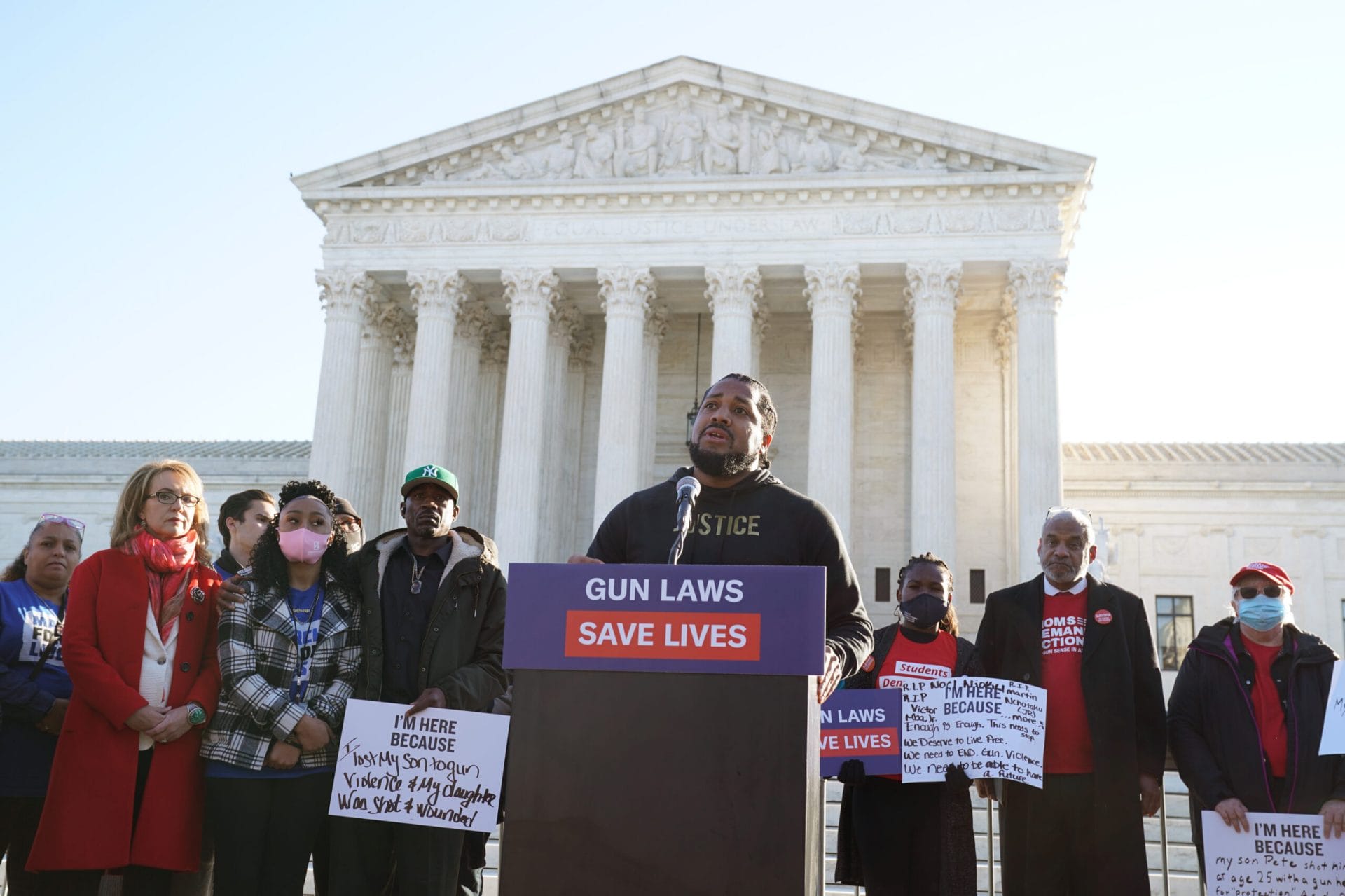
Gun violence survivors speak at a rally outside of the US Supreme Court in November 2021.
Craft Your Narrative
In order to achieve your goal, you’re going to need to craft a narrative that explains why this issue is important to you and why it should be important to others. If you can develop a concise message and a set of talking points related to this message, you’ll be able to articulate your passion for your issue in a variety of situations, including interviews, events, testimony, social media, fundraising, and more.
It may be helpful to begin by answering or thinking through some questions, like the following:
- What happened during the shooting? What did you think, feel, or do?
- What have you experienced since it happened?
- How have your feelings evolved, and what have you done to cope or heal?
- Are there particular things that provoke negative feelings regarding the incident?
- Is there a phrase or sentence that encapsulates your losses or your perspective?
- What have you been moved to do because of the shooting, and why?
- What would you like to see change? Are there any policies that you want to fight for or against?
- What is most important to you about what you’ve experienced, and what do you feel is most important for you to convey?
- Are you ready to share your story?
After thinking through your situation, you can begin to identify the most compelling or important aspects that you want to highlight. You may need to tailor your message to different audiences—just follow the same process and develop what you think is the strongest narrative. And remember, the most impactful message you can convey is how gun violence has affected you.
If you’re interested in more information on persuasion and messaging, check out this messaging guide from the Public Leadership Institute.
Get Your Story into the World
I Gave My Pain a Purpose
Oct 28, 2021
There are an endless number of ways to get your story into the world. You can use social media to create an online presence for yourself; the same goes for blog posts and newsletters, which work even better when you have an established audience to share them with.
In case you aren’t sure of the best way to share your message, here’s a quick breakdown of a few options. Local papers are a great way to increase your chance of publication and to target specific state and local actors, while national press can increase your reach and bring more attention to your issue. You can draft an op-ed and pitch it to an editor, or you can submit a letter to the editor about a local issue or a previously published article. The two most important things are to target your message to your audience, and to make sure your message is crystal clear.
If you want to read some examples, here’s an op-ed Sandy and Lonnie wrote for USA Today, and here’s one Gabby wrote for the Washington Post. And if you want some help deciding how and where to submit your work, check out the OpEd Project.
Social media and blog posts are created by you and made for your audience, and they don’t necessarily need feedback from outside partners. Social media allows you to establish an online profile for yourself, which can be useful when others want to tag you in their content. But because it allows for a more direct line between you to your followers, it can also be an easy place for online attacks.
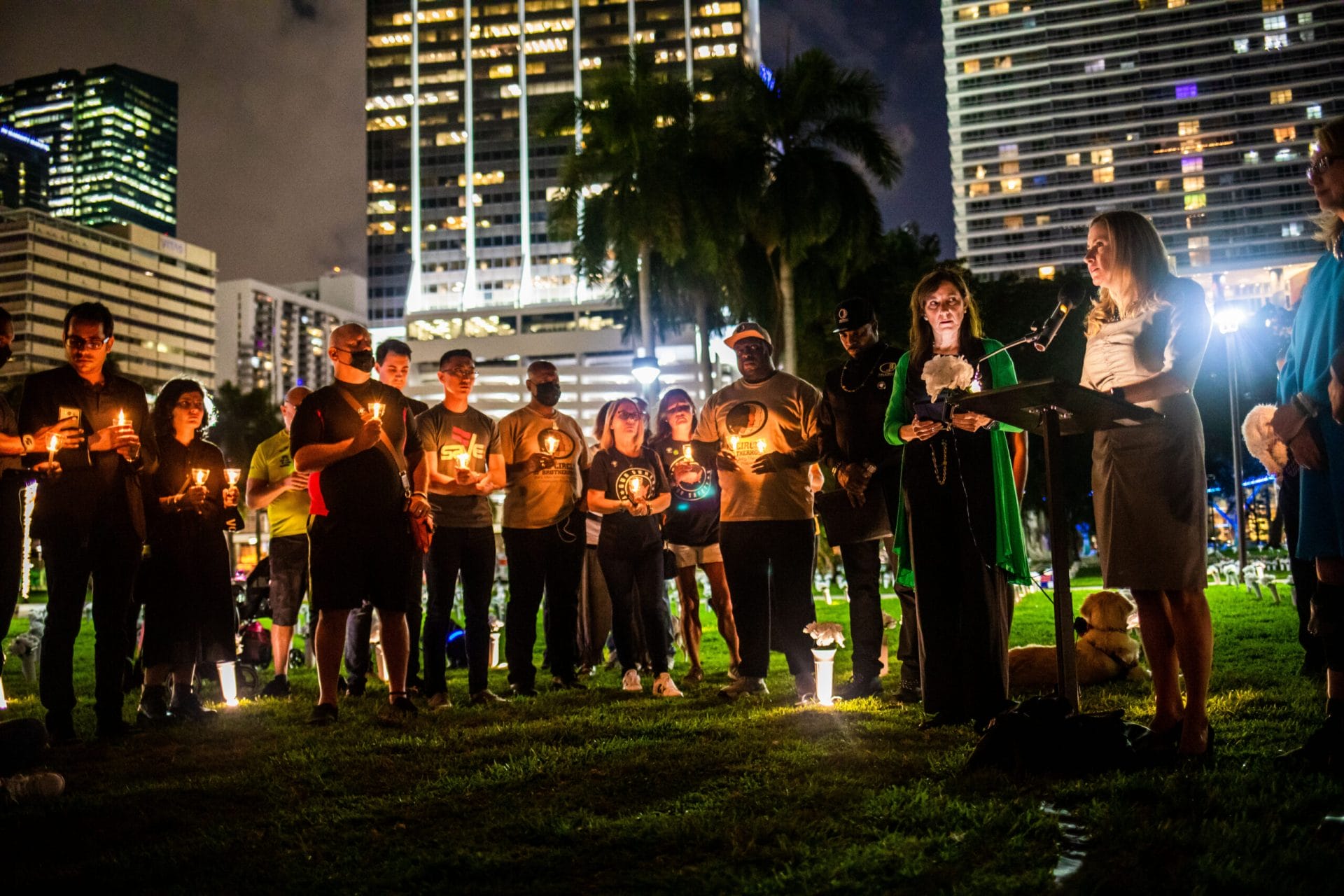
You can also speak to the policymakers in charge of enacting gun safety laws at the local, state, or even national level. Brenda Mitchell bravely shared her story with the US House Committee on Energy and Commerce in order to advocate for addressing gun violence as the public health crisis it is.
If you want to get more creative, you can even rent a billboard—which was done to great effect in Massachusetts!
Whatever you publish or share, you have to own. It will become part of your personal reputation and brand. And remember to focus on the data and evidence that backs up your message—don’t get pulled into the hate and vitriol that often accompanies any online engagement.
Celebrate Victories
This might be the most important part of your advocacy journey. Every group with a goal needs to pause, take stock, thank allies, and trumpet wins. Celebrate! Enjoy it!
Use this celebration as an opportunity to share your victory, bolster spirits, and gain even more support. And after you’re done congratulating yourself, remember to hop back in the fight and map out your next steps.
Conclusion
We hope that this toolkit has resonated with you and helped point you in some fruitful directions. We understand, through our own enormously difficult experiences, the challenging road you are on.
Above all, we hope you know that you are not alone. You have resources, including our steadfast support, and when you are ready, you have power.
Sandy & Lonnie Phillips, Survivors Empowered
Gabby Giffords, Giffords

Former Congresswoman Gabrielle Giffords speaks at the Giffords Gun Violence Memorial on the National Mall in Washington DC in April 2021.
Acknowledgements
With thanks to RubiSparks Communications, Sharon Rubinstein and Leonard Sparks; Penny Okamoto, Survivors Empowered; Aliza Lifshitz, Eric Lundy, Sophie Durham, and Kathleen Toohill, Giffords; Wayne Kaplan; John Rosenthal, Stop Handgun Violence; and Angela Schellenberg.
Additional Advocacy Toolkits
- Giffords Law Center Implementation Toolkit
- National Coalition Against Domestic Violence
- American Public Health Association
- Gun Violence Archive
- Beautiful Trouble Toolbox
- Johns Hopkins Center for Gun Violence Prevention and Policy: Education
- American Association of Suicidology and Harvard School of Public Health: Means Matter
- Giffords: AAPI and Disarming Hate
- National Indigenous Resource Center
- Gays Against Guns
- Delta Research and Educational Foundation
- National Education Association and Teachers Unify to End Gun Violence
- Newtown Junior Action, March For Our Lives, and Team Enough
- The National Resource Center on Domestic Violence and Firearms
TAKE ACTION
The gun safety movement is on the march: Americans from different background are united in standing up for safer schools and communities. Join us to make your voice heard and power our next wave of victories.
GET INVOLVED